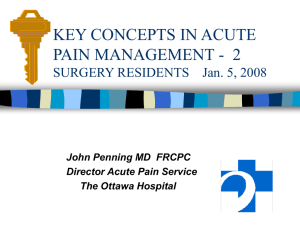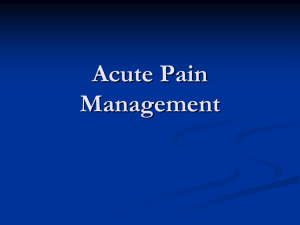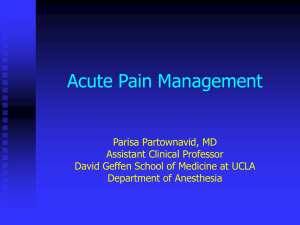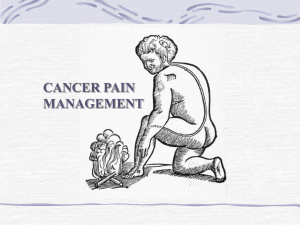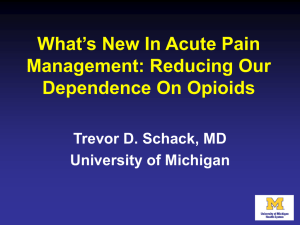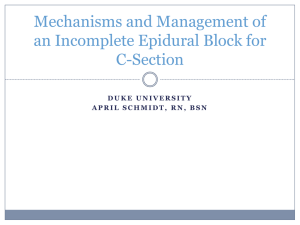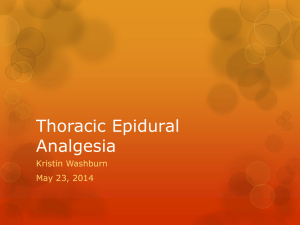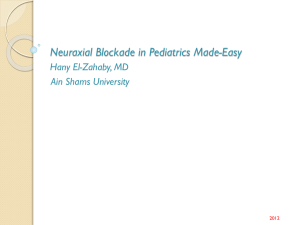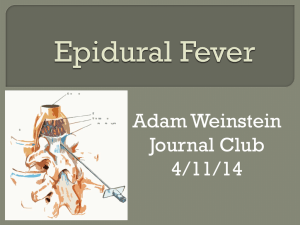KEY CONCEPTS IN ACUTE PAIN MANAGEMENT
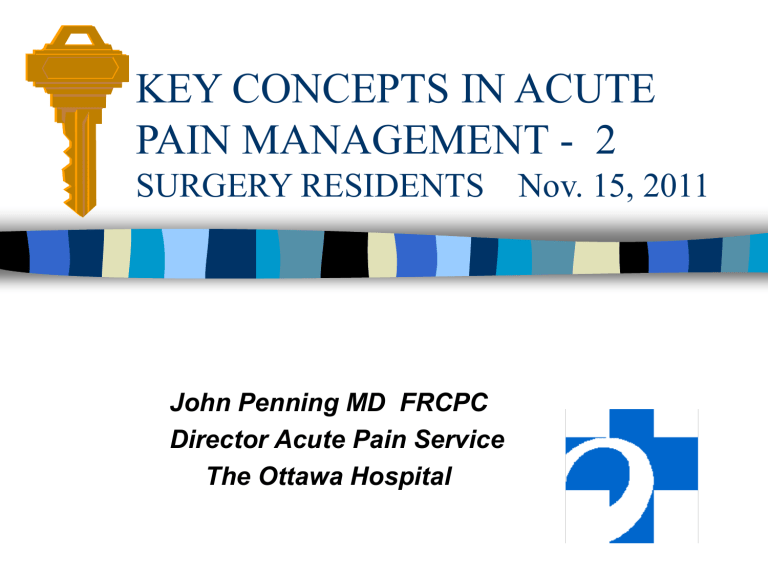
KEY CONCEPTS IN ACUTE
PAIN MANAGEMENT - 2
SURGERY RESIDENTS Nov. 15, 2011
John Penning MD FRCPC
Director Acute Pain Service
The Ottawa Hospital
Objectives
Review the “new” acute pain ladder
When step # 3 on the ladder isn’t working?
– Pronociception, glial activation??
– Role of anti-hyperalgesic drugs
Fundamentals of IV PCA
What is an epidural anyway?
Epidural pitfalls for the surgeon
Review principles discussed by case presentation
– Opioid tolerance, conversion from IV to PO
– When, how to use naloxone
– Assessing the hypotensive epidural patient
Multi-modal Analgesia Orders
Celecoxib 100 – 200 mg PO Q12H
or
Naproxen 250 – 375 mg PO Q8H
Available OTC as “Aleve” 220 mg
Acetaminophen 650 mg PO Q4H
Tramadol 25 – 50 – 75 mg PO Q4H prn
Hydromorphone 1 – 2 mg PO Q4H prn
To supplement Tramadol if required
Case Problem:
32 yr. Male with multiple ribs #
Patient previously healthy, MVA with no other injuries.
In Trauma Unit, c/o 9/10 pain . Difficultly breathing due to severe splinting.
Analgesic orders are:
Hydromorphone 2 – 4 mg PO Q4H prn or
1 – 2 mg SC Q4H prn
Nurse just gave 1 mg S/C one hour ago and now won’t give anything for 3 hours!
What do you do?
Case Problem:
32 yr. Male with multiple ribs #
Review of PHx reveals no drug use.
Patient has received total of 3 mg hydromorphone sc in the 6 hours since admission.
Case Problem:
32 yr. Male with multiple ribs #
Acetaminophen 650 mg PO Q4H W/A
Ketorolac 30 mg IV stat followed by 10 mg IV Q4H.
Tramadol 50 – 75 mg PO Q4H
Hydromorphone 1 – 2 mg s.c. Q2H prn
Hydromorphone 0.5 - 1 mg IV Q1H prn
Case Problem:
32 yr. Male with multiple ribs #
You are at the top of the analgesic ladder and the patient still has inadequate control of acute pain.
With more pain is more opioid always the answer?
NO! Why??
The problem likely is HYPERALGESIA
Scientific American Nov 2009. Pg. 54. Douglas Fields
E = MC
2
Hyperalgesia
Nociceptive
Stimulus
Pro-nociceptive modulation
Anti-nociceptive modulation
Pain
Analgesia
Analgesic Drugs that act by
Nociceptive Modulation
Proantinociceptive
– Augments inhibitory modulation of nociception i.e opioids
Antipronociceptive
– Inhibits the facilitatory modulation of nociception i.e. ketamine, gabapentin and pregabalin
Grande et al. Anesth and Analg Oct 08
NMDA Receptor Antagonists -
To prevent or reverse “pathological” acute pain
Ketamine, Dextromethorphan
– Ketamine is widely known as a dissociative
“general anesthetic” - 3 mg/Kg IV bolus
– Ketamine 2.5 - 5.0 mg IV bolus for analgesia in post-op patient -
– Ketamine as co-analgesic - combined
0.5:1 with hydromorphone IV PCA. Better analgesia, less S/E
– Dextromethorphan 30 mg PO Q8H available OTC as Benylin DM, 3 mg/ml.
Case Problem:
32 yr. Male with multiple ribs #
IV PCA with hydromorphone / ketamine
Ketorolac changed to naproxen when eating. 250 mg PO Q8H
Or
Celecoxib 200 mg PO Q12H for 5 days then 100 mg Q12H until no longer needed.
Case Problem:
32 yr. Male with multiple ribs #
On day three patient is doing well and planning for D/C tomorrow.
Convert to PO hydromorphone.
Daily IV PCA use is 20 mg per day.
Equals about 40 mg per day orally.
Order about 50% as long acting.
9 mg HM Contin Q12H and 2 – 4 mg PO
Q4H prn.
Case Problem:
32 yr. Male with multiple ribs #
Weaning instructions:
As daily “breakthough” hydromorphone requirements decrease, reduce the
HM Contin dose by 25% increments.
The NSAID or coxib is D/C after the opioids D/C
Acetaminophen is last to be D/C
Analgesic Drugs that act by
Nociceptive Modulation
Antipronociceptive
– Inhibits the facilitatory modulation of nociception i.e. ketamine, gabapentin and pregabalin, lidocaine
Pregabalin for acute pain?
Acute pain is “off-label” use
Be cautious of Over-sedation
– Sleep deprivation
– Elderly
– Patient already has significant opioids
Pregabalin:
The Good, The Bad and the Ugly
The Good
– Chronic pain in region of surgery, when pronociceptive mechanisms play a role such as joint arthroplasty, bowel surgery in IBD patients, chronic limb ischemic pain, opioid tolerant patients
The Bad
– Mild pain when simple analgesics like acetaminophen, NSAIDs or low dose opioid or tramadol suffice.
The Ugly
– Too large a dose in sleep deprived patient already in state of “morphine-failure”
Pregabalin dosage
This is NOT a one size fits all.
– Drugs binding to receptors have considerable patient to patient variability in dose:response
Alpha-2 delta sub-unit of Voltage-Gated
Calcium Channel
75 mg PO 2 hours pre-op (50 – 150)
50 mg PO Q8H for 3 to 5 days (25 – 75)
The New Challenges in Managing Acute
Pain after Surgery and Trauma
The Opioid Tolerant Patient
– The greatest change in practice/attitudes in the last 10 years is the now wide spread acceptance of the use of opioids for
CHRONIC NON-MALIGNANT PAIN
– Renders the “usual” standard “box” orders totally inadequate in these patients
Get a pre-op Anesthesia/APS consult
– The Brief Pain Inventory – “BPI”
Eipe and Penning
2009
Opioid Conversions – total daily
ORAL dose equivalents
Tramadol 500 mg
Tapentadol 250 mg
Morphine 100 mg
Oxycodone 50 mg
Hydromorphone 20 mg
Fentanyl patch 25 mcg/hr
The surgeon and IV PCA?
Hydromorphone opioid of choice
– (0.5 mg/ml)
– Less active metabolites than morphine
– Better tolerated in renal insufficiency/elderly
– Safety? In setting of having both available it is better to be more familiar with HM
(substitution errors) i.e. want to avoid giving HM at the morphine dose!
The surgeon and IV PCA?
Loading dose required
– HM: 0.03 mg/kg, 2 mg in 70 kg
Bolus dose
– HM: 0.2 mg (0.1 – 0.4)
Lock-out interval – 6 minutes
Continuous infusion
– Not always required: (0 – 0.2 mg/hr)
One hour limit - ( 1.6 mg)
Naloxone , a two-edged sword!
Is there a down side to the administration of naloxone, 0.4 mg IV in the post-op patient where opioid induced respiratory depression is suspected?
Severe acute pain, sympathetic response, pulmonary edema, MI, dysrhythmias
Case Presentation: Somnolence and hypoxemia while on IV PCA hydromorphone
65 yr. Female with large ventral hernia repair on IV PCA hydromorphone
PMHx: Angioplasty 9 yr. ago, MI, CHF in past
– Moderate COPD, NIDDM
Doing well day 1, but day 2 found to be somewhat confused, somnolent and SaO2 remains in high 80s despite Oxygen by N/P
Is Narcan Indicated? Urgently?
Case Presentation: Somnolence and hypoxemia while on IV PCA Hydromorphone
Further patient evaluation
– Patient arousable, RR 8-16, pupils slightly constricted, BP 130/70, pulse 90 and reg.
– Chest: A/E fair bil. And some mild basilar creps
– ABG: pH 7.46 pCO2 50 pO2 55 BiCarb 36
FiO2 > .50
– Chest X-ray: Extensive bilateral, diffuse, interstitial infiltrate consistent with ARDS
Naloxone would probably have had a serious adverse effect on this patient. Hypoxemia despite supplemental O2 in a breathing patient.
Look beyond the Opioids!
Case Presentation: Somnolence and hypoxemia while on IV PCA Hydromorphone
Management of suspected opioid induced respiratory depression
– Support A/W
– Simulate breathing
– Supply supplemental oxygen
– Assess SaO2, BP, Pulse
– Naloxone titration, IF INDICATED
• 0.04 mg Q5 min. X 3 as needed
Hypoxemia is a medical emergency
Hypercarbia is NOT
Opioids
Issue
With parenteral opioids the patient may experience intolerable side effects before adequate analgesia is attained
Opioids
CONCEPT
Targeted regional administration of opioid results in enhancement of the therapeutic index (ratio of analgesia/side effects)
Neuraxial Opioids – the good
Intrathecal morphine
– simple technique
– potent analgesia for 12 -16 hrs.
– highly effective for pain in lower abdomen and lower limbs
Neuraxial Opioids – adverse effects
Risk of delayed onset of respiratory depression, peaks at 6 hours
Urinary retention >50% for 16 hours
Pruritus, is not an allergy
What is an “EPIDURAL”?
Anatomical
– Location of the catheter, C7 – L5
• Cervical, thoracic and lumbar epidurals
• Segmental Blockade
Drugs
– Opioids (hydrophillic vs. lipophillic)
• morphine, hydromorphone, demerol, fentanyl
• Hydrophillic drugs migrate rostrally and also yield greater spinal selectivity
What is an “EPIDURAL”?
Drugs
– Local Anesthetics :
• Lidocaine, bupivacaine, ropivacaine
Varying concentrations/drug mass produces
“Differential Blockade” sympathetics > somatosensory > motor
– Adjuncts: epinephrine
– Mode of Drug Delivery
– Intermittent bolus vs. continuous infusions
True or False?
Epidural analgesia impairs the resolution of post-operative ileus i.e. it
“slows down the gut” delaying return of normal bowel function.
Epidural analgesia and recovery of bowel motililty??
Thoracic placement of epidural with the administration of local anesthesic and minimal opioid will promote bowel recovery via sympathetic blockade
If the primary mode of epidural analgesia is via potent opioid, recovery of motility may be delayed.
True or False?
Epidural analgesia necessitates a foley catheter until the epidural is removed.
What about epidurals and the foley catheter??
Less Urinary Tract Infection by Earlier
Removal of Bladder Catheter in Surgical
Patients Receiving Thoracic Epidural
Analgesia.
Zaouter C, Kaneva P, Carli F (McGill)
Regional Anesthesia and Pain Medicine
Nov-Dec 2009 pp. 542-552.
Epidural Pit-falls for the Surgeon
Epidural hematoma
– > 50 reported cases in USA in patients treated with LMWH
– Epidural insertion and removal of the catheter
– Risk factors: Elderly, low body weight, twice daily dosing, anti-coagulation vs. prophylactic dose range
The decision to fully anti-coagulate a patient with an epidural in-situ should be made in consultation with anesthesia and thrombosis medicine
Epidural Pit-falls for the Surgeon
More epidural hematoma risks!!
– Heparin 5000 units s.c. Q8H for thromboprophyllaxis??
This is full clinical anti-coagulation for some patients!
Once daily LMWH at thromboprophyllactic dose is safer.
What about anti-platelet agents?
Plavix
– ASRA guidelines state no neuraxial anesthesia or epidural catheters implemented until D/C for 7 days –
– Plavix may be started 12 – 24 hour after neuraxial block or catheter removal
– concensus only, speculative
– Obviously risk is much lower than with heparin/coumadin since reports are extremely rare
– New agents on horizon??
Epidural Pit-falls for the Surgeon
“Masked-Mischief”
– The potential high efficacy of the modality could block pain related to complications
• Peritonitis; anastomosis dehiscence
• Wound infection, wound hematoma
• Limb ischemia, compartment syndrome
– Delay in appropriate therapy, diagnosis
• Neurological problems inappropriately attributed to the epidural i.e. anterior spinal artery syndrome
• Hypovolemia
The “Hypotensive” Patient with an Epidural
64 yr. female, 48 kg, with no Hx of CVS problems, had an esophagectomy for cancer with combined
GA/epidural anesthesia.
Later that evening you are called because the patient’s
BP is 85/50.
Epidural at T5/6 and running hydromorphone 10 µg/ml in 0.1% bupivacaine with epinephrine 2 mcg/ml at 8 ml/hr
The “Hypotensive” Patient with an
Epidural
Possibilities?
“
Normal” for this patient
– all is well and confirmed by Hx and absence of postural changes in BP or HR
– vascular patients may have marked discrepancy between arms – establish baseline pre-op
Surgical complications
Medical complications
Side-effect of Epidural induced sympathetic block
– decreased venous return and decreased SVR
Combination of any 4 above
Is the Epidural causing the hypotension?
What drugs have been administered epidurally?
Pure opioids: morphine, hydromorphone, fentanyl
– sympathetics not blocked directly so look for another cause
Demerol
– mild direct sympatholytic effect and some systemic effects in large doses. Rarely cause of significant
Hypotension. Be careful to R/O other causes.
Local Anesthetics +/- opioids
– In a euvolemic patient with normal CVS function hypotension is unlikely if < 8 sensory dermatomes blocked
Is the Epidural Local Anesthetic causing the hypotension?
Intrathecal catheter migration
Inadvertent overdose
“Un-masking” of problem with the patient.
“Sensitive” patient
Is the Epidural Local Anesthetic causing the hypotension?
Management
ABCs
– supplemental O2, fluid bolus, elevate legs
– ephedrine 5 mg or phenylephrine 50 µg IV bolus
– Hold the epidural infusion
Quantify the extent of block
– motor block? Thoracic epidural?, that’s a problem!
– Sensory block (cold, sharp)
• In a euvolemic patient with normal CVS function hypotension is unlikely if < 8 sensory dermatomes blocked
Management of Hypotension
Cont’d
High thoracic epidural blockade may block the compensatory tachycardia response to hypovolemia.
– Cardio-accelerator sympathetic nerve fibres arise from T1 - T4
– sympathetic block may extend several dermatomes above the sensory blockade
Correct the underlying cause
Remove bupicacaine and change to epidural hydromorphone if patient remains hemodynamically unstable
36 yr. Open Cholecystectomy patient experiencing difficulty weaning from IV PCA
Endometriosis, fibromyalgia and chronic low back pain- has been on Tylenol #3 for several years- functions well and stable usage of 8-
10/day
Day 3 post-op Tylenol #3, 2 tabs Q4h started and IV PCA D/C
Patient c/o severe pain, not able to go home
36 yr. Open Cholecystectomy patient experiencing difficulty weaning from IV PCA
Review of APS meds
– Acetaminophen 650 mg Q4H
– Naproxen 250 mg Q8H
– Pregabalin 50 mg Q8H
– Tramadol 50 mg Q4H
– Plus using 20 mg IV HM in last 24 hr.
Continue above A/N/P/T plus will likely require about 40 mg daily HM PO (4 – 6 mg PO Q4H prn)
Plan for transition back to Fam MD
Conclusion: Key Concepts
The foundation of all acute pain Rx protocols is NSAIDS and acetaminophen.
Codeine is a “pro-drug”. Problems may occur with under or over conversion to morphine
Tramadol to be considered as second step in the acute pain ladder
Naloxone can be a dangerous drug, careful titration is almost always possible
Conclusions
Inadequate analgesia despite cyclooxygenase inhibitors and opioids?
– Think “Hyperalgesia”
– Consider an anti-hyperalgesic like ketamine, pregabalin
All epidurals are not equivalent
Epidural pitfalls
Useful texts
Free!! From Canadian Pain
Society
Managing Pain: The Canadian
Healthcare Professional’s Reference.
Edited by Roman Jovey. 2008.
ACUTE PAIN MANAGEMENT:
SCIENTIFIC EVIDENCE 3 nd Edition Feb ‘10
Australian and New Zealand College of Anaesthetists
And Faculty of Pain Medicine.
http://www.anzca.edu.au/publications/acutepain.pdf
The above web site has the entire document and is freely
Available to download.
Useful websites on Pain
Prospect:Procedure Specific Post-op Pain
Management http://www.postoppain.org/frameset.htm
Pain Explained http://www.painexplained.ca/content.asp?node=4
The Canadian Pain Society http://www.canadianpainsociety.ca/indexenglish.h
tml
Useful websites on Pain
Pain Institute http://www.medscape.com/infosite/paininstitute/article-
5?src=0_0_ad_ldr
Internation Association for the Study of Pain http://www.iasppain.org//AM/Template.cfm?Section=Home
